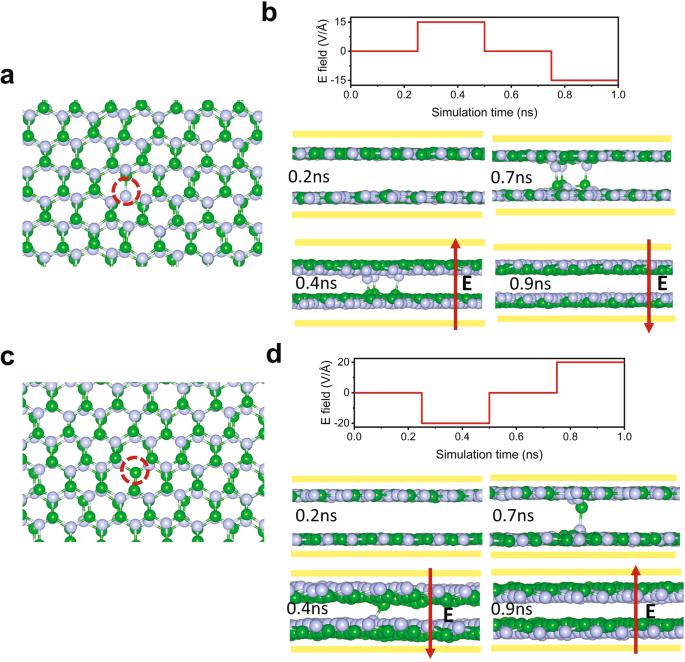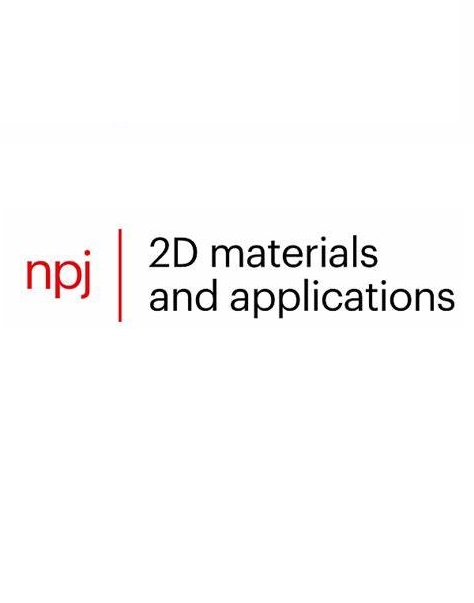Atomistic description of conductive bridge formation in two-dimensional material based memristor
IF 8.8
2区 材料科学
Q1 MATERIALS SCIENCE, MULTIDISCIPLINARY
引用次数: 0
Abstract
In-memory computing technology built on 2D material-based nonvolatile resistive switches (aka memristors) has made great progress in recent years. It has however been debated whether such remarkable resistive switching is an inherent property of the 2D materials or if the metal electrode plays any role? Can the metal atoms penetrate through the crystalline 2D materials to form conductive filaments as observed in amorphous oxide-based memristors? To find answers, here we investigate MoS2 and h-BN-based devices with electrochemically passive and active (metal) electrodes using reactive molecular dynamics with a charge equilibration approach. We find that the SET and RESET processes in active electrode-based multilayer devices involve the formation and disruption of metal filaments linking the two electrodes exclusively through the grain boundaries, the configuration of which affects the volatility of the resistive switching. Whereas the switching mechanisms in passive electrode-based devices require the formation of interlayer B-N bonds and popping of the S atom to the Mo plane at the point defects. We also show that metal atom adsorption at the point defects causes resistive switching in monolayer MoS2. Our atomic-level understanding provides explanations to the apparently contradictory experimental findings and enables defect-engineering guidelines in 2D materials for such disruptive technology.

基于二维材料的忆阻器中导电桥形成的原子论描述
近年来,基于二维材料的非易失性电阻开关(又称忆阻器)的内存计算技术取得了长足的进步。然而,人们一直在争论,这种显著的电阻开关是二维材料的固有特性,还是金属电极起了什么作用?金属原子是否能像在基于非晶氧化物的忆阻器中观察到的那样穿透晶体二维材料形成导电丝?为了找到答案,我们在此采用反应分子动力学和电荷平衡方法,研究了带有电化学被动电极和主动(金属)电极的基于 MoS2 和 h-BN 的器件。我们发现,基于主动电极的多层器件中的 SET 和 RESET 过程涉及完全通过晶界连接两个电极的金属丝的形成和破坏,而金属丝的配置会影响电阻开关的波动性。而被动电极型器件的开关机制则需要在点缺陷处形成层间 B-N 键并将 S 原子弹向 Mo 平面。我们还表明,金属原子在点缺陷处的吸附会导致单层 MoS2 的电阻开关。我们在原子层面上的理解为明显矛盾的实验发现提供了解释,并为二维材料中的缺陷工程提供了指导,以实现这种颠覆性技术。
本文章由计算机程序翻译,如有差异,请以英文原文为准。
求助全文
约1分钟内获得全文
求助全文
来源期刊

npj 2D Materials and Applications
Engineering-Mechanics of Materials
CiteScore
14.50
自引率
2.10%
发文量
80
审稿时长
15 weeks
期刊介绍:
npj 2D Materials and Applications publishes papers on the fundamental behavior, synthesis, properties and applications of existing and emerging 2D materials. By selecting papers with the potential for impact, the journal aims to facilitate the transfer of the research of 2D materials into wide-ranging applications.
 求助内容:
求助内容: 应助结果提醒方式:
应助结果提醒方式:


